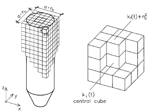 |
Znanstveno-stručni
časopis Hrvatskog društva za geometriju i grafiku Scientific and Professional Journal of the Croatian Society for Geometry and Graphics |
 |
Daniel Lordick (lordick@math.tu-dresden.de)
Shade Lines of Curved Surfaces - Rotational and Helical Circular SurfacesTypically a tangent t to the shade line e of a curved surface Φ is constructed by making use of the fact that t and the light ray l form a pair of conjugate diameters of the so-called DUPIN-indicatix of Φ at an investigated point P. This article describes a very different approach to developing such a tangent: The shade line e is defined as the intersection of Φ and a special ruled surface Ψ, which depends both on Φ and on the bundle of light rays. Ψ is introduced as accompanying ruled surface along e. This approach allows a simple, linear and globally applicable construction of t for rotational and helical surfaces by means of descriptive geometry. The method is also suitable for translation surfaces as well as for central illumination [4]. In a few cases Ψ is a ruled quartic.Keywords: curved surface, Dupin-indicatrix, ruled surface, shades and shadows |
 |
Attila Bölcskei, Mónika Szél-Koponyás (bolcskei@math.bme.hu)
Construction of D-Graphs Related to Periodic TilingsThis paper presents an algorithm which allows to derive classification methods concerning periodic tilings in any dimension, theoretically. By the help of this, one can check former results of the topic (e. g. [BM98, BM00]). An implementation of the algorithm yields the complete enumeration of non-isomorphic three-dimensional D-graphs with 5 elements, given as illustration.Keywords: Delaney-Dress symbol, tiling in n-dimensions |
  |
Damir Lazarević, Josip Dvornik, Krešimir Fresl (damir@grad.hr)
Contact Detection Algorithm for Discrete Element AnalysisThe grid based variation of the contact detection algorithm, with corresponding data structures, is described. This variation is tuned for numerical analysis of large, homogenously distributed assemblages of particles of fairly equal diameters. As an example, algorithm is used in the modelling of granular material silo filling and discharge.Keywords: discrete element method, contact detection, sorting, searching |
   |
Márta Szilvási-Nagy, Teréz P. Vendel, Hellmuth Stachel (szilvasi@math.bme.hu)
C2 Filling of Gaps by Convex Combination of Surfaces under Boundary ConstraintsTwo surface generation methods are presented, one for connecting two surfaces with C2 continuity while matching also two prescribed border lines on the free sides of the gap, and one for G1 filling a three-sided hole in a special case. The surfaces are generated as convex combination of surface and curve constituents with an appropriate correction function, and are represented in parametric form.Keywords: C2 continuity, Convex combination, Coons surfaces, Filling of holes, Surface modelling |
 |
Miljenko Lapaine (mlapaine@geof.hr)
The Curve of Centres and the Curve of all Isotropic Focal points in the Conic Section pencil Given by Two Double points of an Isotropic PlaneConic section pencils given by two double points are discussed. It is proved that the curve of centres decomposes into two straight lines, one of which is passing through the two double base points, while the other is passing through the intersection of common tanget lines of all conics of the pencil and through the centre of the straight segment joining the base points. Furthermore, it is proved that the curve of all isotropic focal points decomposes into a straight line and a conic. These straight line and conic are passing through the double base points of pencil, and the conic through the intersection of common tangent lines of all conics of the pencil.Keywords: conic section pencil, curve of centres, curve of all isotropic focal points, isotropic plane |
 |
Vlasta Szirovicza (szvlasta@juraj.gradnz.grad.hr)
The Conic Given by the Imaginary ElementsIn this paper the construction of some real points of the conic from the pencil of conics is shown. The pencil of conics is given by a double real point and the pair of imaginary points or by the pair of imaginary touching points.Keywords: conic, imaginary points, perspective collineation |
   |
Kamil Maleček, Dagmar Szarková (mail)
A method for Creating Ruled Surfaces and its ModificationsThe paper presents a non-traditional method for defining ruled surfaces. This method enables a simple construction of the ruled surfaces generating lines, not only with the classical means, but first of all with a computer. The method for defining and constructing known surfaces and also modelling of new surfaces is described here. The introduced mathematical description enables creation of the interactive modelling of surfaces by using a computer and very quick surface design and projection of its arbitrary segments. The pictures are presenting the graphical output from a computer.Keywords: developable surface, ruled surface, skew surface |
  |
Györgyi Führer Nagy (fuh@emk.nyme.hu)
Some Remarks to the Paper "The Goose that Laid the Golden Egg"The paper [1] induced me to combine the transcendental curves of LAMÉ with my observations on real bird-eggs [2]. Two segments of di.erent curves are connected at junctions points located on the y-axis. The obtained egglike shape looks nice, but the eye is cheating. It turns out that the curvature of these curves at the junction point has some surprising properties. These imperceptible phenomena are summarized in two theorems.Keywords: bird-egs, egg-shaped curves, golden ratio |
  |
Gunter Weiss, Hans Havlicek (weiss@meth.tu-dresden.de)
Vertex- and Edge-Altitudes of a TetrahedronA k-altitude of an n-simplex meets a k-face and its opposite face orthogonally. A tetrahedron T possesses four "vertexaltitudes"( k = 0) and three "edge-altitudes" (k = 1). The altitudes of each type are generators of special hyperboloids connected with T.The paper treats these hyperboloids in terms of descriptive geometry and gives synthetic proofs for some well-known properties. It turns out, for example, that if the altitudes of one type intersect in one point, then so do the others, and the points of intersection coincide. Keywords: tetrahedron, hyperboloid of altitudes, central projection |